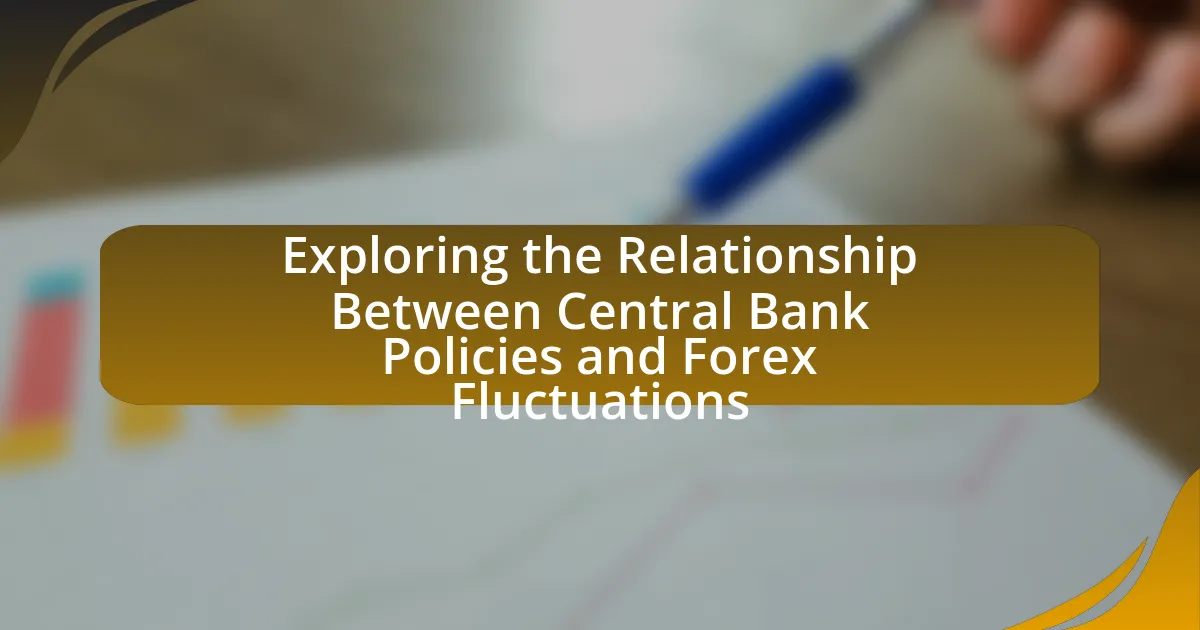The article examines the intricate relationship between central bank policies and fluctuations in the foreign exchange (forex) market. It details how central banks influence currency values through interest rate adjustments, monetary supply changes, and market expectations, highlighting historical examples such as the U.S. Federal Reserve’s actions in 2015. The article also explores the tools used by central banks, the significance of their announcements for forex traders, and the impact of global economic conditions and geopolitical events on monetary policy and currency strength. Additionally, it provides strategies for traders to navigate these fluctuations effectively, emphasizing the importance of risk management and analysis of economic indicators.

What is the relationship between central bank policies and forex fluctuations?
Central bank policies directly influence forex fluctuations through interest rate adjustments, monetary supply changes, and market expectations. For instance, when a central bank raises interest rates, it typically strengthens the national currency as higher rates attract foreign capital, leading to an appreciation in the currency’s value. Conversely, if a central bank lowers interest rates, the currency may depreciate due to reduced returns on investments denominated in that currency. Historical data shows that the U.S. Federal Reserve’s interest rate hikes in 2015 led to a significant strengthening of the U.S. dollar against other currencies, illustrating the direct impact of central bank decisions on forex markets.
How do central banks influence currency values?
Central banks influence currency values primarily through monetary policy, which includes setting interest rates and controlling money supply. When a central bank raises interest rates, it typically attracts foreign capital, leading to an appreciation of the currency due to increased demand. Conversely, lowering interest rates can result in depreciation as capital flows out. For example, the U.S. Federal Reserve’s decision to increase rates in 2015 led to a stronger U.S. dollar against other currencies. Additionally, central banks may engage in foreign exchange interventions, directly buying or selling currencies to stabilize or influence their value. Historical instances, such as the European Central Bank’s interventions during the Eurozone crisis, demonstrate the effectiveness of these strategies in impacting currency values.
What tools do central banks use to affect forex markets?
Central banks use several tools to affect forex markets, including interest rate adjustments, open market operations, and foreign exchange interventions. Interest rate adjustments influence currency value by altering the return on investments denominated in that currency; for example, a higher interest rate typically attracts foreign capital, increasing demand for the currency. Open market operations involve the buying and selling of government securities to regulate money supply, which can also impact currency value. Foreign exchange interventions occur when a central bank directly buys or sells its own currency in the forex market to stabilize or influence its value. Historical examples include the European Central Bank’s interventions during the eurozone crisis, which aimed to stabilize the euro’s value against other currencies.
How do interest rates set by central banks impact currency strength?
Interest rates set by central banks directly influence currency strength by affecting investor behavior and capital flows. When a central bank raises interest rates, it typically attracts foreign capital as investors seek higher returns, leading to an appreciation of the currency. For example, following the U.S. Federal Reserve’s interest rate hikes in 2015, the U.S. dollar strengthened significantly against other currencies. Conversely, when interest rates are lowered, capital may flow out of the country, resulting in a depreciation of the currency. This relationship is supported by the interest rate parity theory, which states that differences in interest rates between countries will lead to changes in exchange rates to maintain equilibrium.
Why are central bank announcements significant for forex traders?
Central bank announcements are significant for forex traders because they directly influence currency values through monetary policy decisions. These announcements can lead to immediate market reactions, as traders adjust their positions based on interest rate changes, quantitative easing measures, or economic outlooks provided by central banks. For instance, when the Federal Reserve signals an interest rate hike, the U.S. dollar typically strengthens against other currencies due to higher returns on investments denominated in dollars. Historical data shows that major announcements, such as the European Central Bank’s policy shifts, can cause currency pairs to experience volatility exceeding 100 pips within minutes. This responsiveness underscores the critical role central bank communications play in shaping forex market dynamics.
What types of announcements do central banks typically make?
Central banks typically make announcements regarding monetary policy decisions, interest rate changes, economic outlooks, and inflation targets. These announcements are crucial as they influence market expectations and can lead to significant fluctuations in foreign exchange rates. For instance, when the Federal Reserve announces a change in interest rates, it often results in immediate reactions in the forex market, reflecting traders’ adjustments to anticipated economic conditions.
How do traders react to central bank communications?
Traders typically react to central bank communications by adjusting their trading strategies based on the perceived implications for monetary policy and economic conditions. For instance, when a central bank signals a potential interest rate hike, traders may increase their positions in currencies expected to appreciate as a result, leading to immediate fluctuations in forex markets. Historical data shows that announcements from central banks, such as the Federal Reserve or the European Central Bank, often result in significant volatility, with currency pairs experiencing sharp movements in response to the tone and content of the communications. This behavior underscores the critical role that central bank messaging plays in shaping trader sentiment and market dynamics.
What role does monetary policy play in forex fluctuations?
Monetary policy significantly influences forex fluctuations by affecting interest rates and money supply, which in turn impact currency values. Central banks, such as the Federal Reserve or the European Central Bank, adjust interest rates to control inflation and stabilize the economy. For instance, when a central bank raises interest rates, it typically strengthens the national currency as higher rates attract foreign capital, leading to increased demand for that currency. Conversely, lowering interest rates can weaken a currency as it may lead to capital outflows. Historical data shows that the U.S. dollar strengthened following the Federal Reserve’s interest rate hikes in 2015, illustrating the direct correlation between monetary policy decisions and forex market reactions.
How does expansionary monetary policy affect currency value?
Expansionary monetary policy typically leads to a depreciation of currency value. This occurs because such policies increase the money supply and lower interest rates, making the currency less attractive to foreign investors. For instance, when the Federal Reserve implements expansionary measures, such as lowering the federal funds rate or purchasing government securities, it often results in a weaker U.S. dollar relative to other currencies. Historical data shows that during periods of significant quantitative easing, like after the 2008 financial crisis, the U.S. dollar weakened against major currencies, reflecting the direct impact of increased liquidity on currency valuation.
What are the effects of contractionary monetary policy on forex rates?
Contractionary monetary policy typically leads to an appreciation of a country’s currency in forex markets. This occurs because higher interest rates, a common tool of contractionary policy, attract foreign capital as investors seek better returns, increasing demand for the currency. For instance, when the Federal Reserve raises interest rates, the U.S. dollar often strengthens against other currencies, as seen during the rate hikes in 2015-2018, which correlated with a stronger dollar. Additionally, contractionary policies can reduce inflation expectations, further enhancing currency value as purchasing power increases relative to other currencies.

How do global economic conditions interact with central bank policies and forex fluctuations?
Global economic conditions significantly influence central bank policies and, in turn, affect forex fluctuations. Central banks adjust interest rates and implement monetary policies based on economic indicators such as inflation, unemployment, and GDP growth. For instance, during periods of economic downturn, central banks may lower interest rates to stimulate growth, which can lead to currency depreciation as investors seek higher returns elsewhere. Conversely, strong economic performance often results in higher interest rates, attracting foreign investment and strengthening the currency. Historical data shows that the U.S. Federal Reserve’s interest rate hikes in 2015 led to a stronger dollar, illustrating this interaction. Thus, the interplay between global economic conditions and central bank actions directly impacts forex markets.
What external factors influence central bank decisions?
External factors that influence central bank decisions include economic indicators, geopolitical events, and market expectations. Economic indicators such as inflation rates, unemployment figures, and GDP growth provide essential data that central banks analyze to determine monetary policy. For instance, a rise in inflation may prompt a central bank to increase interest rates to stabilize prices. Geopolitical events, such as trade tensions or political instability, can also impact central bank decisions by affecting economic stability and investor confidence. Additionally, market expectations, reflected in bond yields and currency valuations, guide central banks in their policy adjustments to maintain economic equilibrium. These factors collectively shape the strategic decisions made by central banks in response to both domestic and international economic conditions.
How do inflation rates affect central bank policy choices?
Inflation rates significantly influence central bank policy choices by guiding decisions on interest rates and monetary supply. When inflation rises above target levels, central banks typically respond by increasing interest rates to curb spending and borrowing, thereby stabilizing prices. For instance, the Federal Reserve raised interest rates multiple times in 2022 in response to inflation rates exceeding 8%, aiming to bring inflation back to its 2% target. Conversely, when inflation is low, central banks may lower interest rates or implement quantitative easing to stimulate economic activity. This relationship is evident in the European Central Bank’s actions during periods of low inflation, where it adopted negative interest rates to encourage lending and investment. Thus, inflation rates directly shape the monetary policy framework central banks employ to maintain economic stability.
What is the impact of unemployment rates on forex markets?
Unemployment rates significantly impact forex markets by influencing currency values and investor sentiment. High unemployment typically signals economic weakness, leading to a depreciation of the national currency as investors seek safer assets. For instance, when the U.S. unemployment rate rose to 10% during the 2008 financial crisis, the value of the U.S. dollar fell against major currencies, reflecting decreased confidence in the U.S. economy. Conversely, low unemployment rates often correlate with economic strength, resulting in currency appreciation as investors anticipate higher interest rates from central banks. Historical data shows that a decrease in unemployment can lead to a stronger currency, as seen when the U.S. unemployment rate dropped to 4% in 2019, contributing to a stronger dollar. Thus, fluctuations in unemployment rates directly affect forex market dynamics through changes in currency valuation and investor behavior.
How do geopolitical events affect central bank policies and currency values?
Geopolitical events significantly influence central bank policies and currency values by altering economic stability and investor confidence. For instance, during geopolitical tensions, such as the Russia-Ukraine conflict, central banks may adopt more accommodative monetary policies to mitigate economic risks, leading to lower interest rates. This can result in depreciation of the national currency, as seen when the Ukrainian hryvnia weakened against the US dollar amid the conflict. Additionally, geopolitical uncertainty often drives investors towards safe-haven currencies like the US dollar and Swiss franc, further impacting exchange rates. Historical data shows that during the Brexit referendum in 2016, the British pound fell sharply as uncertainty about future economic policies emerged, prompting the Bank of England to adjust its monetary stance. Thus, geopolitical events create a direct link between central bank actions and currency fluctuations.
What types of geopolitical events have the most significant impact?
Geopolitical events that have the most significant impact include military conflicts, trade wars, and diplomatic crises. Military conflicts, such as the Russia-Ukraine war, disrupt global supply chains and lead to economic sanctions, affecting currency values. Trade wars, exemplified by the U.S.-China trade tensions, create uncertainty in markets, influencing forex rates due to shifts in trade balances. Diplomatic crises, like the tensions in the Middle East, can lead to volatility in oil prices, which directly impacts currencies of oil-dependent economies. These events create ripple effects in global markets, demonstrating their profound influence on economic stability and currency fluctuations.
How do traders anticipate central bank responses to geopolitical tensions?
Traders anticipate central bank responses to geopolitical tensions by analyzing economic indicators, market sentiment, and historical central bank behavior during similar crises. For instance, when geopolitical tensions arise, traders closely monitor inflation rates, employment data, and GDP growth, as these factors influence central bank decisions on interest rates. Additionally, traders assess central bank communications, such as speeches and policy statements, to gauge potential shifts in monetary policy. Historical examples, such as the Federal Reserve’s response to the 2008 financial crisis, demonstrate that central banks often react to geopolitical events by adjusting interest rates or implementing quantitative easing to stabilize markets. This analytical approach allows traders to make informed predictions about future central bank actions in response to geopolitical developments.

What strategies can traders use to navigate central bank policies and forex fluctuations?
Traders can use several strategies to navigate central bank policies and forex fluctuations, including fundamental analysis, technical analysis, and risk management techniques. Fundamental analysis involves closely monitoring central bank announcements, interest rate changes, and economic indicators, as these factors significantly influence currency values. For instance, a rise in interest rates typically strengthens a currency, while a decrease can weaken it.
Technical analysis allows traders to identify trends and patterns in forex price movements, helping them make informed decisions based on historical data. Utilizing tools like moving averages and support/resistance levels can enhance trading strategies during periods of volatility caused by central bank actions.
Risk management techniques, such as setting stop-loss orders and diversifying currency pairs, are essential for protecting capital against unexpected market shifts. According to a study by the Bank for International Settlements, effective risk management can reduce potential losses during periods of high volatility, which often coincide with central bank policy changes.
How can traders analyze central bank policies effectively?
Traders can analyze central bank policies effectively by closely monitoring official communications, economic indicators, and market reactions. Central banks often release statements, meeting minutes, and economic forecasts that provide insights into their monetary policy direction. For instance, the Federal Reserve’s interest rate decisions and accompanying press conferences can significantly influence currency values, as seen during the 2015 rate hike when the U.S. dollar strengthened against major currencies. Additionally, traders should track key economic indicators such as inflation rates, employment data, and GDP growth, which central banks consider when formulating policies. Analyzing these factors allows traders to anticipate potential market movements and adjust their strategies accordingly.
What resources are available for tracking central bank announcements?
Resources for tracking central bank announcements include official central bank websites, financial news platforms, and economic calendars. Official websites, such as the Federal Reserve, European Central Bank, and Bank of England, provide direct access to press releases and policy statements. Financial news platforms like Bloomberg and Reuters offer real-time updates and analysis on central bank activities. Economic calendars, available on sites like Investing.com and Forex Factory, list upcoming central bank meetings and announcements, helping traders anticipate market movements. These resources are essential for understanding the impact of central bank policies on forex fluctuations.
How can historical data inform trading strategies related to central banks?
Historical data can inform trading strategies related to central banks by providing insights into past monetary policy decisions and their impacts on currency values. Analyzing historical interest rate changes, quantitative easing measures, and inflation targets allows traders to identify patterns and correlations between central bank actions and forex market reactions. For instance, during the 2008 financial crisis, the U.S. Federal Reserve’s aggressive rate cuts and quantitative easing led to a significant depreciation of the U.S. dollar, which traders could have anticipated by studying similar historical precedents. This data-driven approach enables traders to make informed predictions about future market movements based on established trends and central bank behavior.
What are best practices for trading during central bank announcements?
Best practices for trading during central bank announcements include staying informed about the announcement schedule, understanding the central bank’s previous statements and market expectations, and employing risk management strategies. Traders should closely monitor economic indicators that influence central bank decisions, such as inflation and employment data, to anticipate potential market reactions. Historical data shows that currency pairs often experience increased volatility during these announcements, making it crucial to set stop-loss orders to mitigate potential losses. Additionally, traders should avoid entering new positions immediately before the announcement to prevent adverse price movements.
How can traders manage risk during volatile market conditions?
Traders can manage risk during volatile market conditions by employing strategies such as setting stop-loss orders, diversifying their portfolios, and utilizing options for hedging. Stop-loss orders automatically sell a security when it reaches a certain price, limiting potential losses. Diversification reduces risk by spreading investments across various assets, which can mitigate the impact of volatility in any single asset. Additionally, options can provide a way to hedge against adverse price movements, allowing traders to protect their positions. Historical data shows that traders who implement these strategies are better positioned to withstand market fluctuations, as evidenced by studies indicating that diversified portfolios tend to perform more consistently during periods of high volatility.
What indicators should traders watch for during central bank meetings?
Traders should watch for interest rate decisions, forward guidance, and economic projections during central bank meetings. Interest rate decisions directly influence currency values; for example, a rate hike typically strengthens a currency due to higher returns on investments. Forward guidance provides insights into future monetary policy, which can affect market expectations and trading strategies. Economic projections, including GDP growth and inflation forecasts, offer context on the central bank’s outlook and can lead to significant market reactions. Historical data shows that major currency pairs often experience volatility around these announcements, underscoring their importance for traders.
